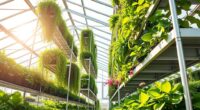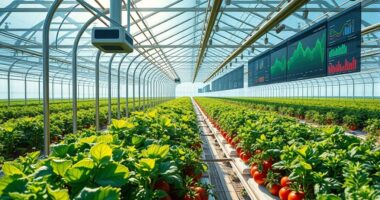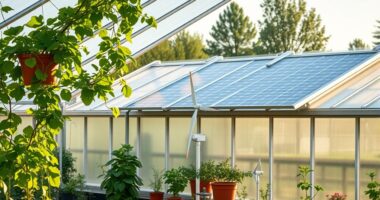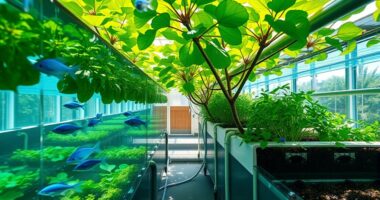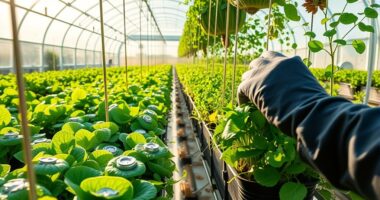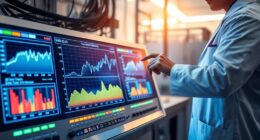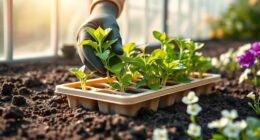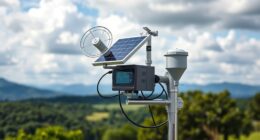Advanced irrigation systems for greenhouses use technologies like drip emitters, micro sprayers, and automated controls to optimize water delivery and reduce waste. Sensors monitor soil moisture, temperature, and plant health, enabling precise watering adjustments. Data analytics and IoT integration help you manage climate, predict needs, and enhance crop growth efficiently. By adopting these solutions, you can improve yields, conserve resources, and ensure sustainable operations—if you continue exploring, you’ll discover more innovative strategies to elevate your greenhouse.
Key Takeaways
- Incorporate automated drip and micro-sprayer systems with real-time sensors for precise water delivery.
- Utilize AI-driven data analytics and predictive models to optimize watering schedules and resource use.
- Integrate environmental sensors and weather data for adaptive, climate-responsive irrigation management.
- Implement modular, scalable solutions compatible with renewable energy to support diverse crop types and expansion.
- Emphasize sustainability by adopting smart, energy-efficient systems that reduce water waste and support organic standards.
Types of Modern Irrigation Technologies

Modern irrigation technologies have revolutionized greenhouse farming by providing efficient and precise water delivery. Drip emitters deliver water directly to plant roots, minimizing waste and promoting healthy growth. They’re ideal for watering individual plants or rows, ensuring consistent moisture levels.
Micro sprayers, on the other hand, spray a fine mist over larger areas, creating a humid environment beneficial for certain crops. They help distribute water evenly across the greenhouse, reducing the risk of over- or under-watering.
Both drip emitters and micro sprayers can be integrated into automated systems, giving you control over irrigation schedules. This precision not only conserves water but also enhances plant health and yields.
Choosing the right technology depends on your crop types, greenhouse size, and specific watering needs.
Benefits of Automated Water Management

Automated water management systems enhance greenhouse efficiency by ensuring your plants receive the right amount of water at the right times. This precision improves drip efficiency, reducing waste and ensuring healthy plant growth. Proper storage of water and nutrients is also crucial for maintaining system effectiveness and plant health. By automating watering schedules, you minimize over- or under-watering, which can stress plants or waste resources. These systems help conserve water by delivering only what’s needed, preventing unnecessary runoff or evaporation. You’ll notice savings on your water bills and a more sustainable operation overall. Additionally, automation reduces manual labor and the risk of human error, allowing you to focus on other aspects of greenhouse management. Regular inspections and adherence to manufacturer guidelines are essential to keep the system functioning optimally. Incorporating nutrient management strategies ensures that plants receive balanced fertilization, further promoting healthy growth and maximizing resource efficiency. Implementing monitoring technology can also aid in maintaining optimal conditions and early detection of potential issues. Utilizing automated control systems can further enhance precision in watering and nutrient delivery, leading to better yields and healthier plants.
Role of Sensors in Precision Irrigation
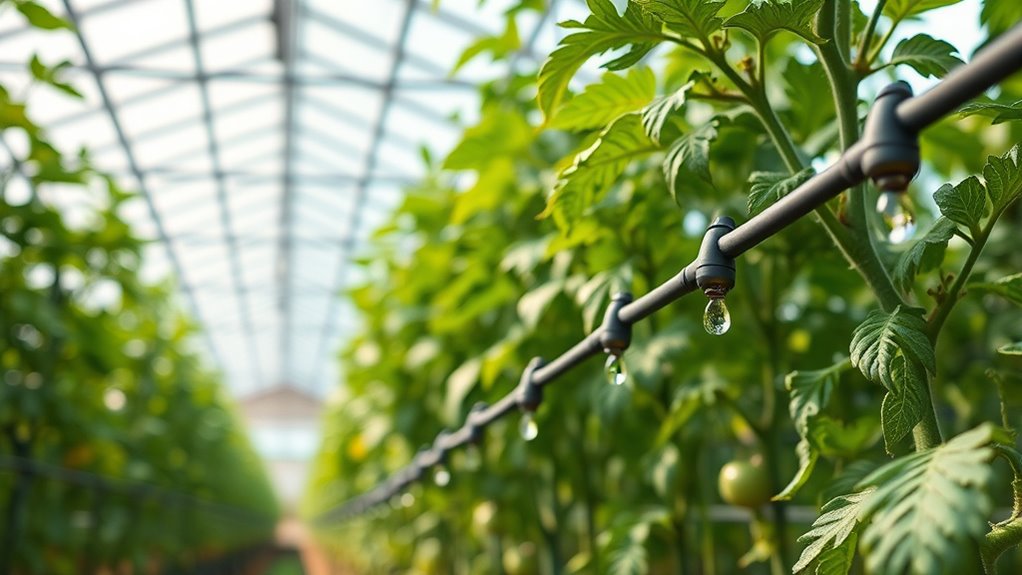
Sensors play a pivotal role in achieving the full potential of precision irrigation by providing real-time data on environmental conditions and soil health. Soil sensors detect moisture levels, nutrient content, and temperature, helping you optimize watering schedules. This data allows for precise control of irrigation, reducing waste and improving efficiency. By monitoring plant health indicators, sensors enable timely adjustments to irrigation, promoting vigorous growth. Additionally, integrating automation technologies with sensor data can further enhance irrigation efficiency. These technologies facilitate data-driven decision making, ensuring that watering practices are both precise and sustainable. Utilizing sensor calibration techniques ensures the accuracy and reliability of the data collected, leading to better irrigation outcomes. Below is a table illustrating key sensor types:
| Sensor Type | Function |
|---|---|
| Soil Moisture | Measures water availability in soil |
| Nutrient Sensors | Detects essential nutrient levels |
| Temperature Sensors | Monitors soil and air temperatures |
| Plant Health Sensors | Assess overall plant vitality |
Integration of Data Analytics for Optimal Growth
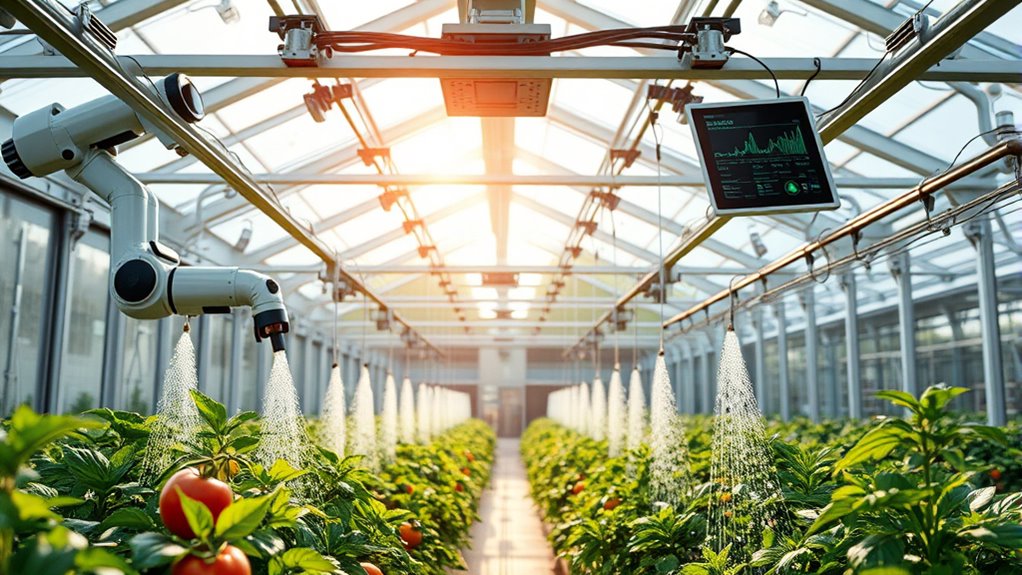
By integrating data analytics, you can optimize your greenhouse’s growth through real-time monitoring techniques that track plant health and environmental conditions. Implementing goal setting strategies ensures your irrigation system aligns with specific cultivation objectives. Predictive growth models help you anticipate needs and adjust irrigation accordingly, ensuring ideal conditions at all times. With data-driven water management, you’ll make smarter decisions that improve yields and conserve resources efficiently. Additionally, leveraging environmental sensors can provide precise data that enhances decision-making and fine-tunes irrigation schedules for maximum efficiency. Incorporating data visualization tools allows for easier interpretation of complex data patterns, facilitating quicker responses to changing conditions. Recognizing the importance of relationships within your team can further streamline operations and troubleshooting processes, leading to more consistent results. Embracing AI bifurcation insights allows for better understanding of how automation and human expertise can work together effectively.
Real-time Monitoring Techniques
Integrating data analytics into real-time monitoring techniques allows greenhouse growers to make informed decisions that enhance plant growth and resource use. By continuously analyzing sensor data, you can adjust irrigation schedules to improve drought resistance and guarantee water quality. This approach helps prevent overwatering or underwatering, promoting healthier plants. It also enables you to detect early signs of water issues, reducing waste and conserving resources. Use real-time data to identify patterns and respond promptly, maintaining ideal conditions for your crops.
- Monitor soil moisture levels and automate watering accordingly
- Track water pH and nutrient content for quality control
- Detect early signs of drought stress or water contamination
- Incorporate filter replacement indicators to maintain optimal system performance
- Leveraging AI-driven analytics can further optimize irrigation strategies and predict system maintenance needs
Predictive Growth Models
How can you enhance crop growth using data analytics? By implementing predictive growth models, you leverage sensor calibration and crop-specific models to forecast plant needs accurately. These models analyze data from sensors measuring temperature, humidity, and nutrient levels, enabling you to anticipate growth patterns. Here’s an example of how different factors interact:
| Factor | Data Input | Impact |
|---|---|---|
| Soil Moisture | Sensor readings | Guides irrigation timing |
| Light Intensity | Light sensors | Adjusts supplemental lighting |
| Nutrient Levels | Sensor calibration data | Ensures ideal fertilization |
Data-Driven Water Management
Harnessing data analytics for water management transforms how you refine irrigation in greenhouses. By analyzing water quality data and plant needs, you can fine-tune irrigation scheduling for maximum efficiency. This approach helps prevent overwatering, conserves resources, and supports healthy growth. Additionally, understanding the physical healing and recovery time after events like childbirth can inform maintenance schedules and prevent disruptions in greenhouse operations. Using sensors and real-time data, you gain insights into soil moisture levels, water pH, and nutrient content, allowing you to make informed decisions. Incorporating personal growth principles can further optimize your management strategies for better outcomes. With data-driven management, you can:
- Adjust irrigation timing based on plant and soil conditions
- Monitor water quality to ensure ideal growing environments
- Reduce water waste through precise scheduling
- Consider the impact of alimony laws and legal factors on operational planning, especially when managing shared resources or facilities. Understanding plant-specific water needs is essential for tailoring irrigation practices effectively. This integration of analytics ensures your greenhouse operates sustainably, improves crop yields, and maintains ideal conditions for plant development.
Drip Irrigation Systems for Greenhouse Cultivation

Drip irrigation systems have become essential for efficient water management in greenhouse cultivation. They deliver water directly to the plant root zones, minimizing waste and ensuring consistent moisture levels. This targeted approach also allows for precise fertilizer application, enhancing nutrient uptake and promoting healthy growth. You can customize drip emitters to control flow rates, optimizing water delivery for different crops. Consider the following options:
| Feature | Benefit |
|---|---|
| Adjustable emitters | Precise water and fertilizer delivery |
| Filtration systems | Prevent clogging and maintain system efficiency |
| Automation controls | Enable scheduled watering and fertilizer timing |
Implementing drip systems improves resource use, supports plant health, and boosts yields by focusing on the plant root zones where water and nutrients are most needed.
Sprinkler and Misting Solutions for Climate Control
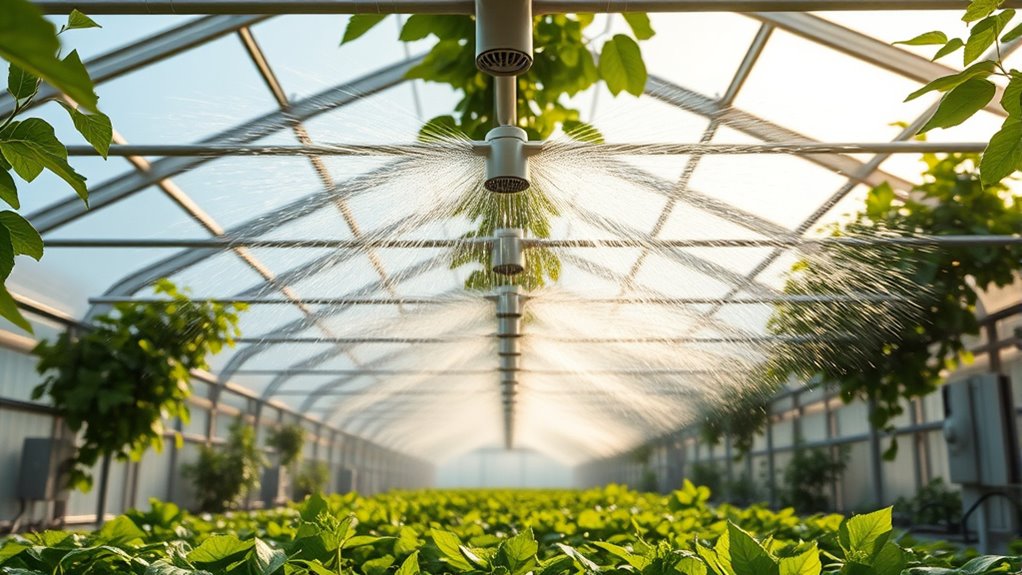
Sprinkler and misting systems play a vital role in maintaining ideal climate conditions inside greenhouses. These solutions help regulate humidity, temperature, and airflow, creating optimal growth environments.
You can choose from various options like spray nozzles that distribute fine mist or sprinkler heads that cover larger areas. Drip emitters can also be integrated to provide targeted moisture, especially during misting cycles.
To enhance performance:
- Use adjustable spray nozzles for precise humidity control
- Incorporate high-pressure systems for even mist distribution
- Combine sprinkler and misting setups for thorough climate management
These systems enable quick responses to changing conditions, improve plant health, and reduce disease risk. Properly configured sprinkler and misting solutions help you maintain a stable, healthy greenhouse environment efficiently.
Water Conservation Strategies in Greenhouse Irrigation

To conserve water in your greenhouse, consider using drip irrigation systems that deliver water directly to plant roots with minimal waste.
Implement rainwater harvesting methods to supplement your supply and reduce dependence on external sources.
Additionally, monitor soil moisture levels closely to make certain you only water when necessary, preventing over-irrigation.
Drip Irrigation Efficiency
Implementing efficient drip irrigation systems can substantially reduce water waste in greenhouse operations. You’ll achieve better fertilizer delivery, as water drips directly to plant roots, minimizing runoff and ensuring nutrients reach their target.
This precision also helps with pest control by reducing excess moisture that attracts pests. To optimize efficiency, focus on:
- Proper emitter placement for uniform water distribution
- Regular maintenance to prevent clogging
- Adjustable timers to match plant needs and growth stages
These strategies ensure your system conserves water, enhances plant health, and reduces chemical use.
Drip irrigation’s targeted approach not only saves water but also improves resource management, making your greenhouse more sustainable and cost-effective.
Rainwater Harvesting Methods
Rainwater harvesting is a practical and effective water conservation strategy for greenhouses. You can maximize rainwater collection by installing gutters and downspouts that direct water into storage systems.
Proper cistern design ensures efficient storage and easy access for irrigation needs. Choose materials like concrete or polyethylene that resist algae growth and contamination.
Make sure your cistern is sealed to prevent debris and pests from entering. Incorporate a filtration system to keep sediments out of your irrigation supply.
Regular maintenance, such as cleaning filters and checking for leaks, keeps your system running smoothly.
By capturing rainwater, you reduce reliance on municipal water sources, lower costs, and promote sustainable practices in your greenhouse.
Effective rainwater harvesting not only conserves water but also enhances your overall irrigation efficiency.
Soil Moisture Monitoring
Have you ever wondered how to maximize water use in your greenhouse? Soil moisture monitoring is essential for maintaining soil health and efficient nutrient management.
By tracking soil moisture levels, you prevent over- or under-watering, which can harm plant roots and reduce yield. Using sensors or tensiometers, you get real-time data that guides watering schedules.
This approach conserves water while promoting healthy soil conditions. Consider these strategies:
- Regularly calibrate moisture sensors for accuracy
- Adjust watering based on moisture data to avoid water waste
- Combine soil moisture info with nutrient levels for ideal fertilization
Implementing soil moisture monitoring ensures your plants receive the right amount of water, enhances soil health, and supports sustainable water conservation in your greenhouse.
Implementing IoT in Greenhouse Water Systems

Integrating IoT technology into greenhouse water systems allows for precise monitoring and control of irrigation processes. With IoT device integration, you can automate smart water scheduling, ensuring plants receive the right amount of water at the right times. This reduces waste and promotes healthy growth. By connecting sensors, valves, and controllers, you gain real-time data to optimize water use efficiently. Below is an example of how IoT enhances irrigation:
| Sensor Type | Function | Benefits |
|---|---|---|
| Soil Moisture | Detects moisture levels | Prevents over/underwatering |
| Temperature | Monitors ambient conditions | Adjusts watering accordingly |
| Flow Rate | Measures water flow | Ensures consistent delivery |
| Light Sensors | Tracks light exposure | Adjusts watering schedules |
| Weather Data | Integrates external data | Adapts to weather changes |
This approach streamlines irrigation, saving resources and maximizing crop health.
Future Trends in Greenhouse Irrigation Technology
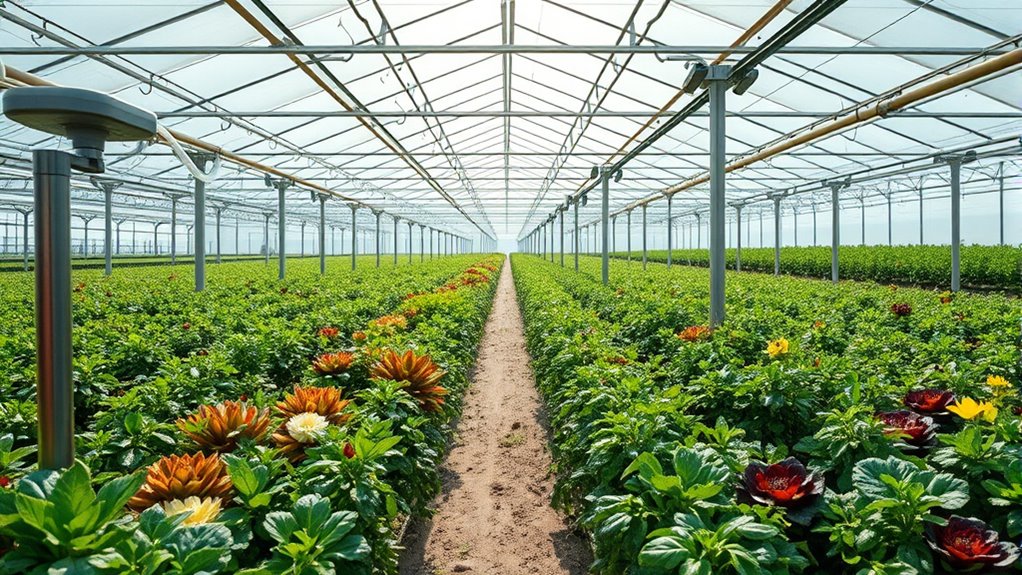
As technology continues to advance, the future of greenhouse irrigation is poised to become more intelligent and sustainable. Innovations will focus on optimizing water use for vertical farming and organic cultivation, reducing waste while boosting crop health.
Future greenhouse irrigation will become smarter and more sustainable, enhancing crop health with optimized water use and innovative technologies.
You can expect smarter systems to integrate AI and machine learning, enabling real-time adjustments based on plant needs. These systems will support precise watering schedules, conserving resources and improving yields.
Additionally, modular and scalable solutions will cater to varying greenhouse sizes and crop types. You’ll see increased adoption of renewable energy sources, like solar-powered irrigation, to further sustainability.
- AI-driven sensors for personalized watering
- Automated systems for organic farming standards
- Solar-powered, energy-efficient irrigation units
Frequently Asked Questions
How Do I Choose the Best Irrigation System for My Greenhouse Size?
When choosing the best irrigation system for your greenhouse size, consider your plant types and water needs. For smaller setups, a drip system offers targeted watering.
Larger areas might benefit from a sprinkler setup for even coverage.
Assess your space, budget, and maintenance preferences.
You can combine both systems if needed, ensuring efficient watering without over- or underwatering, helping your plants thrive and saving water.
What Maintenance Is Required for Advanced Greenhouse Irrigation Systems?
You need to regularly check your irrigation system, focusing on drip emitter maintenance to prevent clogs and guarantee even watering.
Flushing the system periodically removes mineral build-up and debris, keeping everything running smoothly.
Inspect hoses and fittings for leaks or damage, and replace parts as needed.
Proper maintenance helps your system stay efficient, prolongs its lifespan, and keeps your greenhouse plants healthy and well-watered.
Can These Systems Be Customized for Different Plant Types?
You can customize these systems for different plant types by implementing plant-specific watering protocols. Adjust the flow rates to meet each plant’s needs, ensuring ideal hydration without overwatering.
Many systems allow you to set adjustable flow rates, making it easy to tailor watering schedules for delicate seedlings or drought-tolerant plants. This flexibility helps you promote healthier growth and efficient water use, regardless of the plant variety you’re cultivating.
What Is the Typical Installation Cost of Automated Irrigation Solutions?
Think of installation costs as planting seeds for your greenhouse’s future. You’ll need to take into account cost estimation and budget planning to cultivate success.
Automated irrigation solutions typically range from a few hundred to several thousand dollars, depending on system complexity and size.
By carefully planning your budget, you can ensure your investment flows smoothly, watering your plants efficiently without draining your resources.
It’s an investment that grows with your greenhouse dreams.
How Do Weather Conditions Affect Irrigation Scheduling in Greenhouses?
Weather conditions critically influence your irrigation scheduling. By monitoring weather prediction, you can adjust watering times to prevent over- or under-watering.
Humidity control becomes essential, especially during high humidity periods, to avoid fungal issues and guarantee ideal plant growth.
You should remain flexible with your schedule, using real-time data to fine-tune irrigation, making sure your greenhouse maintains the right moisture levels regardless of external weather changes.
Conclusion
By embracing advanced irrigation systems, you’ll unveil a world where water flows as precisely as a maestro’s baton, nurturing your greenhouse like a well-tended garden of dreams. These smart technologies act as your dedicated allies, ensuring ideal growth while conserving resources. As you step into the future, let innovation be the compass guiding your green thumb, turning your greenhouse into a thriving oasis where efficiency and sustainability bloom hand in hand.

